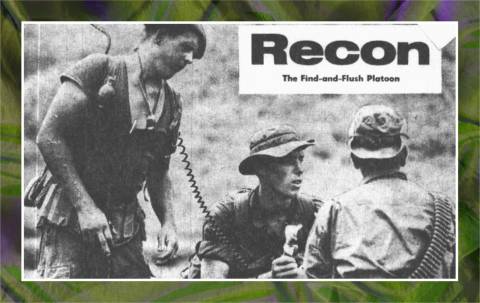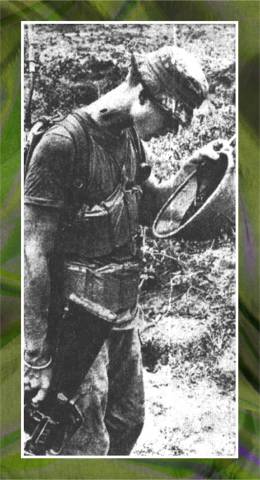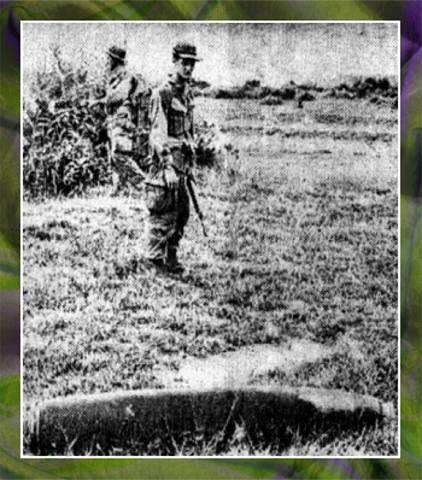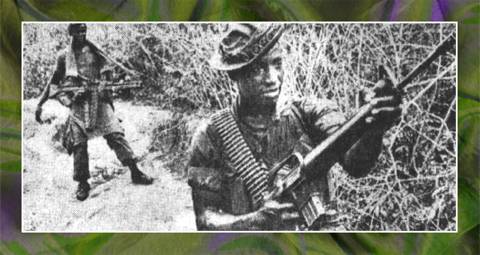![]()
DUC PHO, RVN--On the same day two Americans set foot on the moon, another group of Americans were taking a different kind of walk. They were the men of the recon platoon, 3d Bn, 1st Inf, 11th Brig, Americal Div.

Lt. Vitters checks in on radio while recon men patrol the area.
-- OW Photos by Richard Boyle
Two days earlier, two companies of the 3d Bn had fought a knockdown, drag-out battle with at least a battalion of the North Vietnamese Army.
After contact was broken off, the enemy vanished. S2 thought they might be trying to move east toward Duc Pho, base camp of the 11th Brig.
That battalion had to be found and the job of finding it was given to the recon platoon.
In two columns, the 21 men of the patrol cautiously moved out into the valley. No one spoke and all instructions were given by hand signals. First Lt Alan Vitters, a West Pointer, was walking with his pointman as the small unit moved along the valley floor. "I sometimes like to walk with my pointman, it gives him confidence," said the platoon leader.
One of the missions of the patrol was to check out the scene of a hard-fought battle at the center of the valley. The area was littered with NVA pith helmets, pieces of uniforms, canteens and AK rounds.
The patrol also found a burned-out APC and several GI helmets.

Trooper checks out dead NVA's helmet pith.
-- OW Photos by Richard Boyle
Although the NVA managed to remove most of their dead, the patrol did discover some they left behind. From a shallow grave marked by a pith helmet (the NVA apparently didn't have time to dig the grave deep enough) a green and withered hand of a North Vietnamese soldier jutted out. Throughout the battlefield lay small pieces of bone and burned flesh, grim evidence of the vicious night.
Vitters' platoon apparently beat the NVA to the area, because the patrol also found an unexploded 500-pound bomb. The dinks love to take explosives from undetonated bombs to make charges for booby traps. The platoon's demo man blew the 500-pounder while the rest of the platoon hugged the ground several hundred meters away.

Recon men patrolling the area.
-- OW Photos by Richard Boyle
Later in the afternoon, the platoon came across some fresh, bare footprints. Vitters sent a squad up a ridge overlooking the valley to check out a suspected NVA base camp.

Recon men patrolling the area.
-- OW Photos by Richard Boyle
The camp was deserted, but the Americal troopers did manage to destroy several bags of rice left behind by the NVA.
Brigade brass are quick to point out that the mission of the recon platoons, one of which is allocated to each battalion, is vital. Although LOCH choppers gather a great amount of intelligence, it takes men on the ground to actually flush the NVA from their well-concealed spider holes. If the small platoon does run into a large enemy force, it can be hairy. Help, however, will usually come within 15 minutes.
Able to move fast and silently, recon patrols can come up with information that a regular infantry company couldn't.
On one recent patrol, the platoon zapped an NVA officer sleeping in a hammock. The detailed map and documents they found in his pocket turned out to be of great value to S2.
The Americal Div discovered the value of recon platoons against the Japanese at Guadalcanal during the second world war. The first American Army unit to conduct an offensive operation against the enemy in World War II, the Americal Div also has the distinction of probably being the only division that was formed overseas in two wars.
The division, first formed on May 27, 1942, was composed of a hodge-podge of various units originally called Task Force 6814. Since the new division was located in New Caledonia, the name was derived from combining "America" and "Caledonia."
After fighting on Guadalcanal, the division moved to the Fiji Islands, and later saw action on Bougainville. On Jan. 8, 1945, the Americal troopers helped clean out Japanese forces in the Phillippines and was stationed in Japan after the war. The division was deactivated soon afterward.
A quarter of a century later, the Americal div was reformed, ironically in much the same way as in the second world war. A multibrigade task force organized to fight in the troubled I Corps of Vietnam was reconstituted the Americal Div on Sept. 25, 1967.
The division's AO, one of the longest in Vietnam, stretches 95 miles. With about 24,000 troops, the division is the largest in the U.S. Army.
![]()
![]()